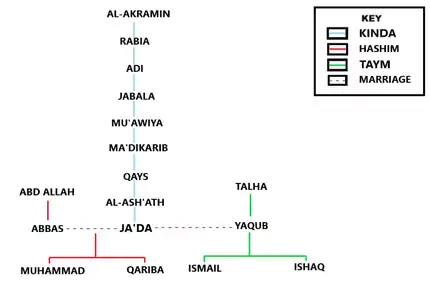Ja'da bint al-Ash'ath
Ja'da bint al-Ash'ath al-Kindi (Arabic: جعدة بنت الأشعث الكندي, romanized: Ja'da bint al-Ash'āth al-Kindī) was a wife of caliph Hasan ibn Ali (c. 625–670). She belonged to the Kinda tribe.
| Ja'da bint al-Ash'ath | |||||
|---|---|---|---|---|---|
| Consort of the Caliph | |||||
| Born | Kufa or Yemen | ||||
| Spouse | Hasan ibn Ali | ||||
| |||||
| Tribe | Kinda (by birth) Hashim (by marriage) | ||||
| Father | Al-Ash'ath ibn Qays | ||||
Biography
Ja'da was a daughter of al-Ash'ath ibn Qays, a companion of the Islamic prophet Muhammad. Following the fourth Rashidun caliph Ali's (r. 656–661) arrival in Kufa, al-Ash'ath consulted with his tribal kinsmen to marry his daughter to Ali's son and later caliph Hasan. According to the modern historian Wilfred Madelung, Ali married Hasan with Ja'da to maintain good ties with the Kinda tribe.[1]

In 670, Hasan was poisoned and a few sources named Ja'da as the poisoner. Among these sources was Al-Shaykh al-Mufid (c. 948–1022), who even claimed that caliph Mu'awiya I (r. 661–680) promised to pay Ja'da 100,000 dirham and marry his son Yazid I (r. 680–683) to her.[2] These reports further claim that after Ja'da poisoned Hasan, Mu'awiya payed the amount but refused to marry Yazid to Ja'da.[2] Al-Mufid's narratives were taken by later Shia scholars, and Mu'awiya was solely accused as the 'real killer' of Hasan.[2] The Belgian historian Henri Lammens (c. 1862–1937) considers these reports as 'insignificant'.[3] These reports are likely Alid propaganda to Ja'da, who was considered a traitor.[4] According to the prominent early historian Haytham ibn Adi (c. 738–822), Suhayl ibn Amr's daughter Hind, who was also a wife of Hasan, was the poisoner of the Imam.[5]
Following Hasan's death, Ja'da married Yaqub, a son of the Rashidun commander Talha ibn Ubayd Allah.[4] After Yaqub was killed at the Battle of al-Harra in 683, Ja'da married Abbas ibn Abd Allah, a son of the prominent scholar Ibn Abbas (c. 619–687). She bore a son named Muhammad and a daughter Qariba, both of whom left no descendants.[6]
References
- Madelung 1997, p. 380.
- Pierce 2016, p. 83.
- Madelung 1997, p. 331–332.
- Ahmed 2011, p. 143.
- Madelung 1997, p. 384.
- Bewly 2013, p. 315.
Bibliography
- Ahmed, Asad Q. (2011). The Religious Elite of the Early Islamic Ḥijāz: Five Prosopographical Case Studies (Illustrated ed.). Occasional Publications UPR. ISBN 978-1900934138.
- Bewly, Aisha (2013). Kitab al-Tabaqat al-Kabir. Vol. 5. Ta-Ha Publishers.
- Pierce, Matthew (2016). Twelve Infallible Men: The Imams and the Making of Shi'ism. Harvard University Press. ISBN 9780674737075.
- Madelung, Wilferd (1997). The Succession to Muhammad: A Study of the Early Caliphate. Cambridge University Press. ISBN 0-521-64696-0.